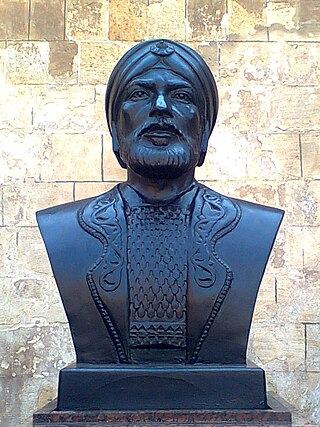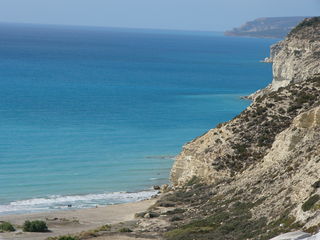
The Kingdom of Cyprus was a medieval kingdom of the Crusader states that existed between 1192 and 1489. Initially ruled as an independent Christian kingdom, it was established by the French House of Lusignan after the Third Crusade. It comprised not only the entire island of Cyprus, but it also had a foothold on the Anatolian mainland: Antalya between 1361 and 1373, and Corycus between 1361 and 1448.

Janus was King of Cyprus and titular King of Armenian Cilicia and Jerusalem from 1398 to 1432.

Lord Edward's Crusade, sometimes called the Ninth Crusade, was a military expedition to the Holy Land under the command of Edward, Duke of Gascony in 1271–1272. It was an extension of the Eighth Crusade and was the last of the Crusades to reach the Holy Land before the fall of Acre in 1291 brought an end to the permanent crusader presence there.

The Bahri Mamluks, sometimes referred to as the Bahri dynasty, were the rulers of the Mamluk Sultanate of Egypt from 1250 to 1382, following the Ayyubid dynasty. The members of the Mamluk ruling class were purchased as slaves (mamluks) and manumitted, with the most powerful among them taking the role of sultan in Cairo. While several Bahri Mamluk sultans tried to establish hereditary dynasties through their sons, these attempts were ultimately unsuccessful, with the role of sultan often passing on to another powerful Mamluk.

The House of Lusignan was a royal house of French origin, which at various times ruled several principalities in Europe and the Levant, including the kingdoms of Jerusalem, Cyprus, and Armenia, from the 12th through the 15th centuries during the Middle Ages. It also had great influence in England and France.

Saif ad-Din Qutuz, also romanized as Kutuz or Kotuz and fully al-Malik al-Muẓaffar Sayf ad-Dīn Quṭuz, was a Turkic military leader and Mamluk Sultan of Egypt. He reigned as Sultan for less than a year, from 1259 until his assassination in 1260, but served as the de facto ruler for two decades.

Al-Ashraf Salāh ad-Dīn Khalil ibn Qalawūn was the eighth Turkic Bahri Mamluk sultan, succeeding his father Qalawun. He served from 12 November 1290 until his assassination in December 1293. He was well known for conquering the last of the Crusader states in Palestine after the siege of Acre in 1291. While walking with a friend, Khalil was attacked and assassinated by Baydara and his followers, who was then killed under the orders of Kitbugha.

Shajar al-Durr, also Shajarat al-Durr, whose royal name was al-Malika ʿAṣmat ad-Dīn ʾUmm-Khalīl Shajar ad-Durr, was a ruler of Egypt. She was the wife of As-Salih Ayyub, and later of Izz al-Din Aybak, the first sultan of the Mamluk Bahri dynasty. Prior to becoming Ayyub's wife, she was a child slave and Ayyub's concubine.
The Battle of Fariskur was the last major battle of the Seventh Crusade. The battle was fought on 6 April 1250, between the Crusaders led by King Louis IX of France and Egyptian forces led by Turanshah of the Ayyubid dynasty.

The siege of Acre took place in 1291 and resulted in the Crusaders' losing control of Acre to the Mamluks. It is considered one of the most important battles of the period. Although the crusading movement continued for several more centuries, the capture of the city marked the end of further crusades to the Levant. When Acre fell, the Crusaders lost their last major stronghold of the Crusader Kingdom of Jerusalem. They still maintained a fortress at the northern city of Tartus, engaged in some coastal raids, and attempted an incursion from the tiny island of Ruad; but, when they lost that, too, in a siege in 1302, the Crusaders no longer controlled any part of the Holy Land.

Buffavento Castle is a castle in Northern Cyprus. The exact date of its construction remains unknown, the most plausible theory being the Byzantine period. It combines Byzantine and Frankish architectural elements. It fell into disuse in the 14th century.

The brief Alexandrian Crusade, also called the sack of Alexandria, occurred in October 1365 and was led by Peter I of Cyprus against Alexandria in Egypt. Although often referred to as and counted among the Crusades, it was relatively devoid of religious impetus and differs from the more prominent Crusades in that it seems to have been motivated largely by economic interests and was not called or endorsed by the Pope.
Stefano Lusignan (1537–1590), also known as Étienne de Lusignan and Estienne de Lusignan, was a priest, scholar, and titular bishop of Venetian Cyprus who migrated to Italy and France.

Guy of Ibelin was the dominican bishop of Limassol, Cyprus from 27 April 1357 until his death. He belonged to the noble Cypriot house of Ibelin, closely linked by intermarriage with the kings of Cyprus. His father Balian of Ibelin, Lord of Arsuf, was a direct descendant of the first Balian of Ibelin, an important crusader. His mother, Margaret of Ibelin, continued to hold the title Lady of Arsuf after her husband's death. In the second half of the fourteenth century the fortunes of the house of Ibelin were in decline, as the once-powerful family became extinct. Guy's brother Philip became the last Ibelin to hold the title Lord of Arsuf. He was executed in Genoa in late 1373 for taking part in the assassination of King Peter I of Cyprus in 1369; King James I of Cyprus subsequently bestowed the title on John of Neviles, viscount of Nicosia, in 1389.

Episkopi is a village lying partly in the Limassol district of Cyprus and partly in the British Overseas Territory of Akrotiri and Dhekelia. It is approximately 14 km (9 mi) west of Limassol and 40 km (25 mi) east of Paphos. Episkopi is built on the hill of ancient Kourion, close to the western bank of the Kouris River.

Akanthou is a village on the northern coast of Cyprus. It is under the de facto control of Northern Cyprus. As of 2011, it had a population of 1,459.

The fall of Ruad in 1302 was one of the culminating events of the Crusades in the Eastern Mediterranean. In 1291, the Crusaders had lost their main power base at the coastal city of Acre, and the Muslim Mamluks had been systematically destroying the remaining Crusader ports and fortresses in the region, forcing the Crusaders to relocate the dwindling Kingdom of Jerusalem to the island of Cyprus. In 1299–1300, the Cypriots sought to retake the Syrian port city of Tortosa, by setting up a staging area on Ruad, two miles (3 km) off the coast of Tortosa. The plans were to coordinate an offensive between the forces of the Crusaders, and those of the Ilkhanate. However, though the Crusaders successfully established a bridgehead on the island, the Mongols did not arrive, and the Crusaders were forced to withdraw the bulk of their forces to Cyprus. The Knights Templar set up a permanent garrison on the island in 1300, but the Mamluks besieged and captured Ruad in 1302. With the loss of the island, the Crusaders lost their last foothold in the Holy Land and it marked the end of crusader presence in the Levant region.

Al-Malik al-Ashraf Sayf al-Din Abu an-Nasr Inal al-'Ala'i az-Zahiri an-Nasiri al-Ajrud was the 13th Burji Mamluk sultan of Egypt, ruling between 1453–1461.

The Amathus sarcophagus is a Cypriot sarcophagus that likely held a king of Amathus. Its sides show procession scenes and typify Cypriot, Greek and Phoenician-Near Eastern styles of the mid-fifth century BCE. The sarcophagus was excavated by Luigi Palma di Cesnola and is currently located at the Metropolitan Museum of Art.
In the year 1220, the Ayyubid fleet launched a sea raid against the port of Limassol in Cyprus. The raid ended in success for the Ayyubid fleet.

















